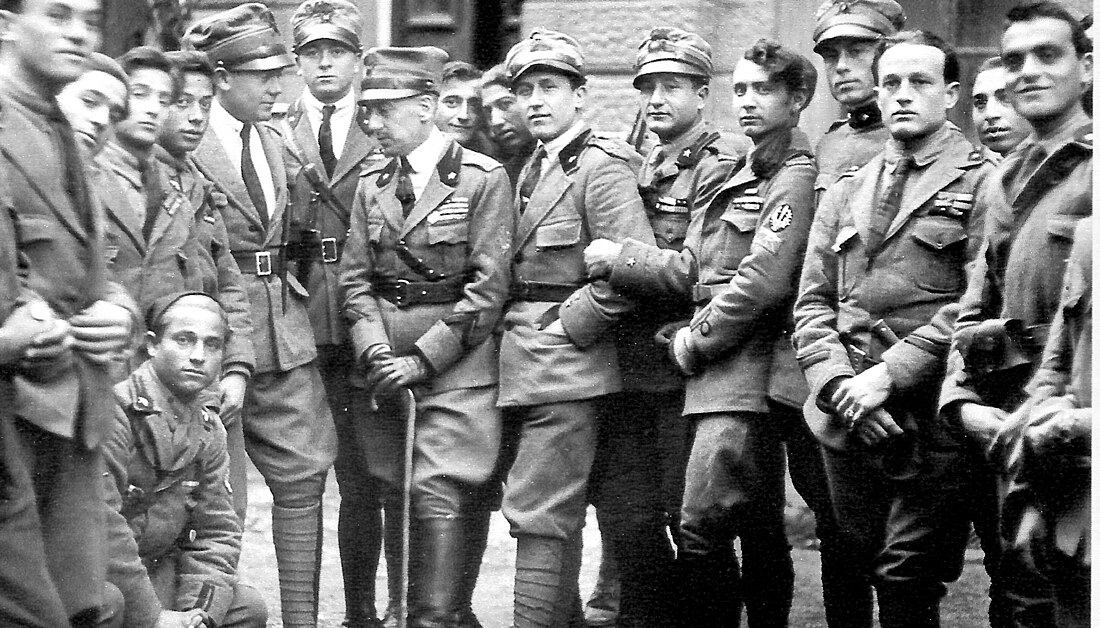Top Qs
Timeline
Chat
Perspective
Proto-fascism
Ideologies and cultural movements forming the basis of fascism From Wikipedia, the free encyclopedia
Remove ads
Proto-fascism represents the direct predecessor ideologies and cultural movements that influenced and formed the basis of fascism.[1][2] The term protofascism is also used in a slightly more general sense to refer to any political movement whose activities make the emergence of fascism more likely. Proto-fascist movements that preceded fascism featured some of the common characteristics of fascist ideology, such as the scapegoating of ethnic or religious minorities, the glorification of violence, and the promotion of the Führerprinzip, the belief that the party and the state should have a single leader with absolute power, but usually did not exhibit some characteristics of fascism, for example, were less radical or lacked totalitarian ambitions. In relation to contemporary politics, the term protofascist has been applied to movements which resemble fascist ones in certain respects, but cannot be defined strictly as neo-fascist.[3]

Remove ads
Historical movements
Summarize
Perspective
Italy
A prominent proto-fascist figure is Gabriele D'Annunzio, the best-known Italian poet of the first half of the 20th century, and an Italian nationalist whose politics influenced Benito Mussolini and Italian fascism. After World War I, D'Annunzio led a group of Arditi volunteers who occupied the port of Fiume and proclaimed the Italian Regency of Carnaro. The Italian Nationalist Association (Associazione Nazionalista Italiana, ANI), which advocated for an authoritarian corporatist nationalist state is also considered an influential proto-fascist organization. The Italian futurist movement in arts and culture, led by such figures as Filippo Tommaso Marinetti, also displayed certain key characteristics of Fascism, such as radical nationalism and cult of violence, destruction, and war.[1][3]
Germany
In Germany, the Völkisch nationalist movement which arose in the late 19th century became seen as one of the precursors of Nazi fascism; among the important elements of Völkisch culture was Blut und Boden romanticism.[4] After World War I, the proto-fascist movements of the Weimar Republic included the Freikorps militias, which combatted the leftists between the German Revolution of 1918 and the Nazi seizure of power (see Political violence in Germany in 1918—1933), the Stahlhelm, a revanchist and authoritarian nationalist World War I veteran organization, the German National Association of Commercial Employees (Deutschnationaler Handlungsgehilfen-Verband, DHV), the German National People's Party (Deutschnationale Volkspartei, DNVP) from 1931 onwards.[2][3]
Spain
The historians Paul Preston and Julián Casanova, who treat Francoism as a Spanish variant of fascism,[5] note that "Spanish fascism" was established by the unity of the right-wing groups and parties and the military rebels, which formed the Nationalist faction of the Spanish Civil War. According to them, the Spanish anti-republican right which would later support the rebellion, including the cultural association Acción Española which propagated the idea of an anti-republican military uprising, the nationalist authoritarian corporatist party CEDA, the organization Spanish Renovation, and the Carlist Requetés, shared a political culture, similar to the Italian proto-Fascism and the German Völkisch movement. In the Civil War, the Spanish right, including the military rebels, underwent further political radicalization and fascisation; as Preston writes, "throughout the Civil War, the politics of the army were indistinguishable from contemporary fascisms."[6][7]

Russia
This section needs expansion. You can help by adding to it. (July 2025) |
In the Russian Empire, proto-fascism was represented by the Black Hundreds movement and such its organizations as the Union of the Russian People (Russian: Союз русского народа, romanized: Soyuz russkogo naroda; СРН/SRN).[8]
Remove ads
Historical individuals
Summarize
Perspective
Prominent historic individuals who have been labeled proto-fascist because they shared an ideological basis with fascism include:
- Joseph de Maistre (1753–1821)[9]
- Thomas Carlyle (1795–1881)[10]
- Paul de Lagarde (1827–1891)[11][12][13]
- Hermann Goedsche (1815–1878)[14]
- Goldwin Smith (1823–1910)[15][16]
- Georges Ernest Boulanger (1837–1891)[17]
- George Fitzhugh (1806–1881)[18]
- Georges Vacher de Lapouge (1854–1936)[19]
- R. A. Schwaller de Lubicz (1887–1961)[20][21]
- Charles Maurras (1868–1952) [22]
- John Ruskin (1819–1900)[23][24]
- Ion Dragoumis (1878–1920)[25][26]
- Vladimir Purishkevich (1870–1920)[27][28][29]
- D. H. Lawrence (1885–1930). The English philosopher Bertrand Russell characterized Lawrence as a "proto-German fascist".[30] This characterization is useful as a demarcation point between fascism and proto-fascism. The former has totalitarian uniformity as its paradigm, but Russell is referring to Lawrence as a "nonconformist prophet" struggling with individual alienation, looking to the shared identity of ancestral blood and soil for reconnection i.e. an evolution of the German 19th-century Völkisch movement,[31][32] an ideology that was adopted by the Nazis.
- Giuseppe Mazzini (1805–1872). The famous Genoese patriot strongly influenced Italian fascism, especially in its early years. In particular, fascism inherited from Mazzini the fervent irredentism, the concept of class collaboration, the pedagogical vocation and the spirit of solidarity. Mussolini himself was a great Mazzini admirer, and many fascist exponents were Mazzinian such as Italo Balbo, Giovanni Gentile, Giuseppe Bottai, and Dino Grandi.[33]
- Francesco Crispi (1818–1901). The known Sicilian statesman was admired by the dictator Mussolini and considered by many scholars as a precursor of Italian fascist regime due to his authoritarian policies, the nationalist character, his strongman reputation, and the aggressive colonial policy implemented during his government.[34][35]
- Rudolf Steiner (1861–1925)[36]
Remove ads
References
References
Wikiwand - on
Seamless Wikipedia browsing. On steroids.
Remove ads
